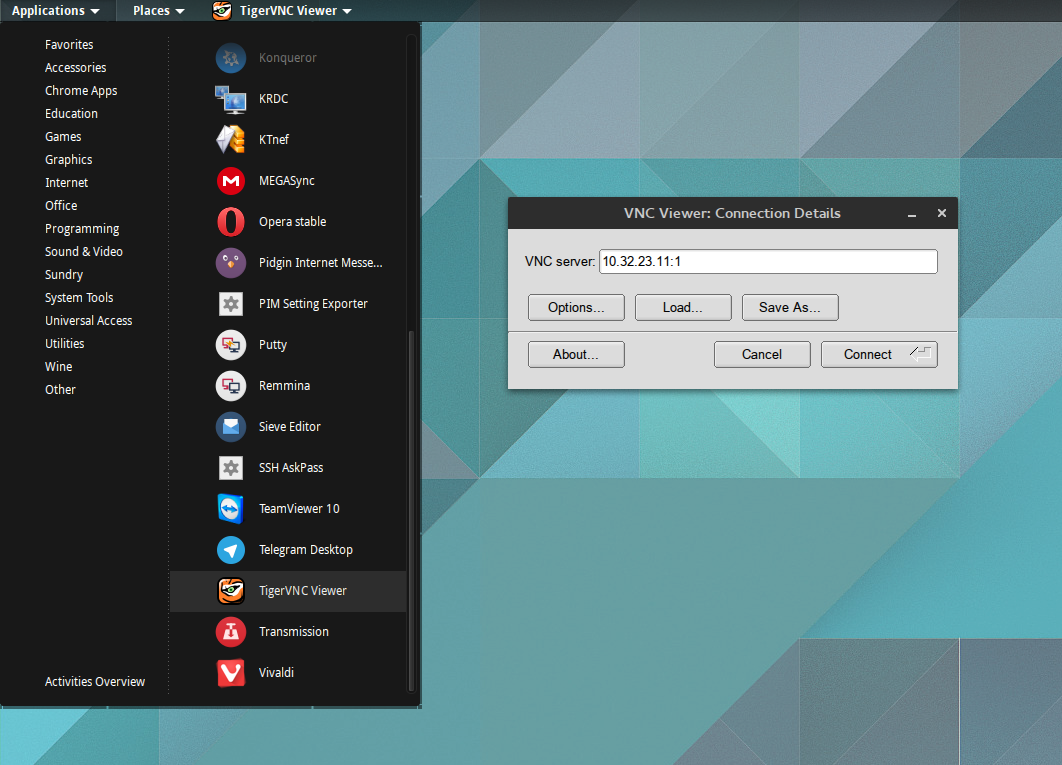
Any help, guidance, or ideas on how it would be possible to get this feature added would be highly appreciated. TigerVNC seems to be the only one that supports whatever form of authentication IT has setup on the server, and is the only one that IT will officially support anyway.īut without client scaling, it's practically unusable for my setup when changing between 2 locations with different resolution capabilities. I also tried TightVNC and RealVNC viewers, similar issues. Something about unsupported or incorrect authentication or encryption modes. I tried using that with whatever server our IT is running (I'm not sure what it is, but I don't think it's TigerVNC server, and I'm not sure how I find out what it is) and it didn't work.
#Tigervnc resolution code
Do different open source versions of VNC ever share that kind of code with each other? I think it was mentioned above that TurboVNC supports client scaling. When I tell vncviewer to use fullscreen, the remote system window (1600x1200) is centered across both monitors with large black spaces on both sides. This is probably a stupid question, but I think there are other VNC clients that already support this feature. The client system has two monitors using Nvidia twinview, with an effective resolution of 3200x1200. Not sure how likely that would even be, but without a price tag on getting it done for sure, I can't really even ask the question.

Now reboot your RPi, and you will have a VNC Server ready.The reason I asked what it would take is because I had the crazy idea of seeing if there was any possibility of getting my company to pay for it.
#Tigervnc resolution install
Make a directory if not already made $ mkdir ~/.config/autostartĬreate a file named sktop or any with the following content Windows: Download and install tigervnc64-x.y.z.exe (64-bit) or tigervnc-x.y.z.exe (32-bit), where x.y.z represents the latest version. vncserver :3 New desktop is tk04:3 Starting applications specified in /.vnc/xstartup Log file is tk04:3. But at some point, The VNC session can be generated with only vncserver command, and the following option doesn't affect the result as below.
#Tigervnc resolution password
Run the server from shell prompt with password $ x11vnc -usrpw -display :0 Usually, we typed vncserver -depth 24 -geometry 1920x1080 to generate a VNC session. Install x11vnc Server $ sudo apt-get install x11vnc

Then try the following command $ update-rc.d vncboot defaults If enabling dependency based boot sequencing was successful, it says $ update-rc.d: using dependency based boot sequencingīut if it says $ update-rc.d: error: unable to read /etc/init.d//etc/init.d/vncboot Make the file executable using this command $ chmod 755 /etc/init.d/vncbootĮnable dependency based boot sequencing $ update-rc.d /etc/init.d/vncboot defaults usr/bin/vncserver :0 -geometry 1280x800 -depth 16 -pixelformat rgb565Įcho "Usage: /etc/init.d/vncboot " #Insert your favoured settings for a VNC session # Description: Start VNC Server at boot time. # Short-Description: Start VNC Server at boot time Once that is done you can start a VNC server from shell prompt using below command: $ vncserver :0 -geometry 1366x768 -depth 24Ĭreate a file in /etc/init.d with any name such as vncserver with following content: #!/bin/sh Next run TightVNC Server which will prompt you for the password and an optional View Only password. Install TightVNC Server $ sudo apt-get install tightvncserver You can go with x11vnc, if you want single desktop to be shared among every VNC client and the RPi itself. You can start as many independent Xvnc sessions as you want. You can install TightVNC but it creates a separate desktop for every connection. TigerVNC supplies a X server (Xvnc) that operates similar to Xvfb (no physical display device is needed), except it supports more extensions and the rendered output is available to VNC clients. Check the Sample screenshotssection for examples. Since the key components arent bound to Ubuntu or GNOME, you can use your favorite distro and GUI.

For this setup, I will use Ubuntu 20.04 LTS (Focal Fossa, unfortunately 22.04 does not work), and install GNOME Desktop. In order to get VNC connection, you need to install a VNC server in RPi. The key component we need to install is tigervnc-standalone-server.


 0 kommentar(er)
0 kommentar(er)
